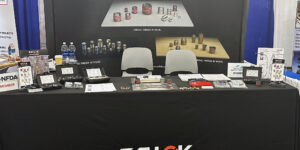HOW SHOT PEENING SYSTEMS REDUCE COSTS FOR THE OIL AND GAS INDUSTRY
Shot peening provides considerable increases in part life because the overlapping dimples it creates form a uniform layer of compressive stress at metal surfaces.
Posted: March 3, 2010
TRC Rod Services of Oklahoma (TRC Company; Oklahoma City, OK) was formed in 1996 by a group of veterans in the sucker rod business. TRC is the industry leader in helping major and independent oil and gas companies extend the life of their respective sucker rods through the company?s inspection and reconditioning services. Sucker rods are one of the most crucial components in a working oil well, connecting the pump jack at the surface of the well to a down-hole pump. The 25 ft steel rods are joined by threaded couplings to make a string approximately 5,000 ft long.
TRC has built a loyal customer base that recognizes the importance of shot peening. TRC?s rod processing plant in Oklahoma City operates at full capacity, which has led to the need for further expansion. In February 2009, the company opened a state-of-the-art facility situated on thirteen acres. TRC?s new sucker rod plant was based on the design of a rod plant built in 2007 by TRC?s sister company, TRC Rod Services (Midland, TX).
?Shot peening is the most valuable and cost-effective process for sucker rod owners,? explains Bob Payne, the originator of the sucker rod reconditioning process. Shot peening is a cold working process in which shot, small spherical media, bombard the surface of a part. During the shot peening process, each piece of shot that strikes the material acts as a tiny peening hammer, imparting to the surface a small indentation or dimple. To create the dimple, the surface of the material must yield in tension. Below the surface, the material tries to restore its original shape, thereby producing, below the dimple, a hemisphere of cold-worked material highly stressed in compression.
Nearly all fatigue and stress corrosion failures originate at the surface of a part, but cracks will not initiate or propagate in a compressively stressed zone. Because the overlapping dimples from shot peening create a uniform layer of compressive stress at metal surfaces, shot peening provides considerable increases in part life. Compressive stresses are beneficial in increasing resistance to fatigue failures, corrosion fatigue, stress corrosion cracking, hydrogen assisted cracking, fretting, galling and erosion caused by cavitation. The maximum compressive residual stress produced just below the surface of a part by shot peening is at least as great as one-half the yield strength of the material being shot peened.
In most modes of long-term failure, the common denominator is tensile stress. Tensile stresses attempt to stretch or pull the surface apart and may eventually lead to crack initiation. Because crack growth is slowed significantly in a compressive layer, increasing the depth of this layer increases crack resistance. Shot peening is the most economical and practical method of ensuring surface residual compressive stresses.
Shot peening also can induce the aerodynamic curvature in metallic wing skins used in advanced aircraft designs. Additional applications for shot peening include work hardening through cold work to improve wear characteristics, closing of porosity, improving resistance to intergranular corrosion, straightening of distorted parts, surface texturing and testing the bond strength of coatings.
When it came to outfitting the new Midland facility, TRC collaborated with Wheelabrator Group (LaGrange, GA) technical sales representatives to install a new shot peening machine. The Skew Roll Peening machine (with one blast wheel) is one of the most important components of the new facility?s daily manufacturing operations. TRC worked closely with Wheelabrator engineering personnel in designing a new machine capable of effectively shot peening rods at a rate of 75 fpm and that could be placed in line with the company?s other inspection and reconditioning processes.
?Sucker rod failures have the potential of costing our customers millions of dollars each year,? says Don Heck, president of TRC. ?At the heart of our reconditioning service is shot peening, which gives new life to used rods by greatly reducing residual stress. Our services prevent costly failures at a fraction of the cost of purchasing a new string of rods.?
The shot peening process relieves the residual stresses built up in the sucker rods from down-hole usage, providing the benefits of (1) increased strength and, (2) durability. The constant movement and weight on the rod string (via the force and rotation of the pump jack) generates significant residual stresses in the sucker rods, often leading to costly breaks in the rods. Shot peening also helps prevent corrosion of sucker rods when they are in oil wells by placing the outer layer of the rods into compression. The anchor pattern supplied by shot peening also allows a corrosion inhibitor to attach easily. The role of the inhibitor is to prevent corrosion during storage and everyday use.
TRC maintains a competitive edge as the sole company within the oil and gas industry that utilizes the shot peening process to recondition sucker rods. This is a reason why TRC is able to offer a written warranty on used sucker rods that is comparatively equal to the warranty on new rod products, resulting in a cost savings for their oil and gas customers.
—————————————————————-
Wheelabrator Group, 1606 Executive Drive, LaGrange, GA 30240, 800-544-4144, Fax: 706-884-0568, WheelabratorGroup.com, info@wheelabratorgroup.com.
Some of this material originally appeared in the article ?Shot Peening Reduces Costs for Oil Companies? in The Shot Peener, Summer 2009 issue.









